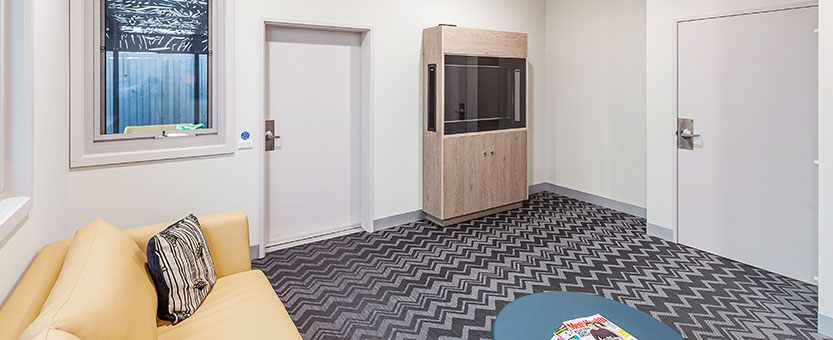-
1300 994 890Property Management1300 832 373Consulting & Certification
What is a Breakout room in an SDA Robust home?

A separate room is designed to respond to the individual disability-related needs of the participant. This means the rooms contain finishes and equipment suited to the preferences of the resident and tailored to support their needs. It does not need to be a large room, however, should have enough circulation space for furniture and equipment.
For people in the community with very high needs, securing suitable housing can be a challenge – but now, Specialist Disability Accommodation (SDA) aims to change this. SDA is available to participants of the National Disability Insurance Scheme (NDIS) who are assessed as needing a special housing solution. It provides financial support to help people with high need disability to rent, buy or build a home that includes the support features that they need.
Robust housing is a category within the NDIS SDA design options, purposefully built to provide a high level of physical access provisions. A robust home is achieved using products, materials and features that minimize the risk to participants and the community and reduce the frequency of reactive maintenance.
The design includes adequate space and safeguards to support the needs of residents with complex behaviours and provides areas of retreat for other residents and staff to avoid harm.
 A recently added feature to the Robust category within the new standard is the Breakout Room, a separate room designed to respond to the individual needs of the participant. It is not designed for use as a study of living / dining area but aimed at providing opportunities for learning, exploring, or relaxation. This type of room would typically contain equipment, sound and lighting for appropriate activities to each resident.
A recently added feature to the Robust category within the new standard is the Breakout Room, a separate room designed to respond to the individual needs of the participant. It is not designed for use as a study of living / dining area but aimed at providing opportunities for learning, exploring, or relaxation. This type of room would typically contain equipment, sound and lighting for appropriate activities to each resident.
It is important to note a breakout room is not used as a seclusion room, and there are stark differences between the two. A seclusion room provides for the sole confinement of a distressed or agitated person requiring separation for short periods at any time on an involuntary basis. Studies show the use of seclusion rooms to cause negative experiences in both participants and staff. The use of Breakout rooms however, are a less distressing approach intended to soothe, calm and encourage a sense of playfulness and curiosity.
The requirements of the breakout room within the new SDA design standard includes:
- A dedicated area intended for use to enhance learning, exploration or positively impact mood. A living room used for both general recreation and for breakout purposes may cause conflict and unnecessary distress for residents.
- The expected use of activities, equipment, sound and lighting in ways that are appropriate to current residents. When designing Breakout rooms where the proposed residents are unknown, flexibility and adaptability is key, where equipment can be used for a range of different activities or adapted to suit resident preferences. For example, lighting with interchangeable colour filters and sound equipment which offers silent vibrational features as well as audible tones.
It is important to note a breakout room is not a mandatory requirement in any SDA design category, however, it is highly recommended in Robust homes to enhance a resident’s coping mechanisms and support their quality of life.
In fact, studies have shown breakout rooms, or multi-sensory environments as they are also known as, to provide many benefits to health and wellbeing. The use of sensory rooms has been shown to create positive experiences for participants, such as letting go of control and increased self-confidence, emotional self-care and well-being.
For more information and guidance on what to include in your breakout room design, see https://www.disabilityaccessconsultants.com.au/multi-sensory-rooms-and-environments/
Funding for Robust SDA is available on new builds and existing stock. For compliance, all SDA dwellings must be designed and maintained to a standard that is consistent with the surrounding properties and neighbourhood, they must recognise the importance of outdoor areas and must be built on land that is an adequate size for the number of residents.
For more information on how to design and build Robust housing, see https://sdaconsulting.com.au/how-to-design-and-build-robust-housing/
Bruce has over 32 years of experience in disability access, architectural design, documentation & project management
He formed Equal Access Pty Ltd in 2006 in response to growing recognition, that whilst businesses were being urged to respond to their obligations under the Disability Discrimination Act, the majority of assistance available was focused almost entirely upon the needs of the individual with a disability without an understanding of the impacts and practicalities for building owners, managers and consultants.
Bruce also specialises in evacuation procedures and policy for people with a disability and is a member of the Standards Australia development committee FP-017 Emergency Management Planning – Facilities (AS3745)
